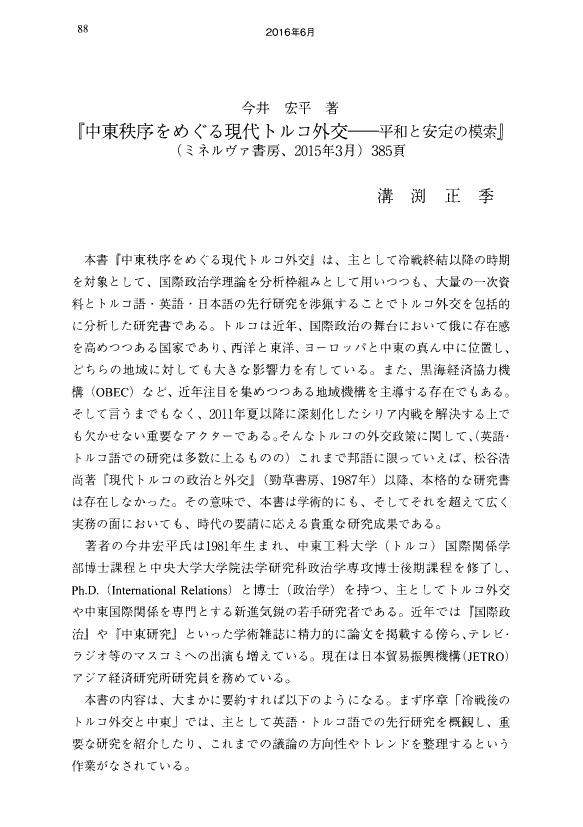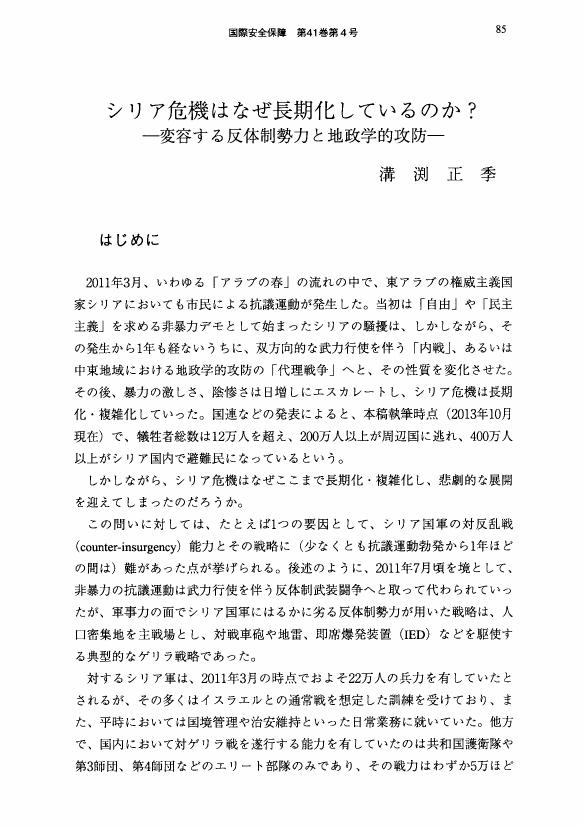2 0 0 0 OA 戦略的資産か政治的負債か? ―サウジアラビアにおける米軍基地と基地政治―
- 著者
- 溝渕 正季
- 出版者
- 国際安全保障学会
- 雑誌
- 国際安全保障 (ISSN:13467573)
- 巻号頁・発行日
- vol.47, no.3, pp.55-75, 2019-12-31 (Released:2022-03-14)
2 0 0 0 OA 「アラブの春」後の中東における非国家主体と政治構造
1 0 0 0 OA 今井 宏平 著『中東秩序をめぐる現代トルコ外交――平和と安定の模索』
- 著者
- 溝渕 正季
- 出版者
- 国際安全保障学会
- 雑誌
- 国際安全保障 (ISSN:13467573)
- 巻号頁・発行日
- vol.44, no.1, pp.88-92, 2016-06-30 (Released:2022-04-01)
1 0 0 0 OA シリア危機はなぜ長期化しているのか? ―変容する反体制勢力と地政学的攻防―
- 著者
- 溝渕 正季
- 出版者
- 国際安全保障学会
- 雑誌
- 国際安全保障 (ISSN:13467573)
- 巻号頁・発行日
- vol.41, no.4, pp.85-101, 2014-03-31 (Released:2022-04-07)
- 著者
- 溝渕 正季
- 出版者
- 国際安全保障学会 ; 2001-
- 雑誌
- 国際安全保障 (ISSN:13467573)
- 巻号頁・発行日
- vol.41, no.4, pp.85-101, 2014-03
- 著者
- 溝渕 正季
- 出版者
- 一般財団法人 日本国際政治学会
- 雑誌
- 国際政治 (ISSN:04542215)
- 巻号頁・発行日
- vol.2016, no.183, pp.183_134-183_137, 2016-03-25 (Released:2016-09-27)
1 0 0 0 OA レバノン人の越境移動に関する経験と意識:「新しいフェニキア人」像の再考
- 著者
- 髙岡 豊 浜中 新吾 溝渕 正季
- 出版者
- 日本中東学会
- 雑誌
- 日本中東学会年報 (ISSN:09137858)
- 巻号頁・発行日
- vol.28, no.1, pp.35-58, 2012-07-15 (Released:2018-03-30)
The paper considers the experiences and the perceptions of the Lebanese toward cross-border movement and explains its effects on contemporary Lebanese politics and societies. To this end, we analyzed the results of “Middle East Opinion Poll (Lebanon 2010),” which was conducted by the Beirut Center for Research and Information (BCRI) in May and June 2010. There are some widespread stereotyped images about the Lebanese; for example, they are cosmopolitan, multilingual, and business-oriented, and tend to be entrepreneurial. These images have led the Lebanese to be commonly known as the “New Phoenicians” or a typical case of “Trade Diasporas.” However, the credibility of these images has not necessarily been verified. In this paper, therefore, we attempted to verify the stereotyped image that all the Lebanese are cosmopolitan, by scientific methods and rethought conventional wisdom. The result suggests that all the Lebanese and Lebanese emigrants not necessarily embody the stereotyped images of “New Phoenicians” and “Trade Diasporas,” and there is room for further research on the patterns of cross-border movement of the Lebanese.
- 著者
- 溝渕 正季
- 出版者
- JAPAN ASSOCIATION OF INTERNATIONAL RELATIONS
- 雑誌
- 国際政治 (ISSN:04542215)
- 巻号頁・発行日
- vol.2014, no.178, pp.178_73-178_87, 2014
Since 1903, the year when Wright brothers made a success of building the world's first successful airplane and making the first controlled, powered and sustained heavier-than-air human flight, airpower has developed astoundingly as an essential component in modern warfare. Up until today, it has been demonstrated by several modern wars. At the same time, however, this was not always the case. In unconventional warfare (or asymmetric warfare, "Non-Trinitarian Warfare," "Fourth Generation Warfare,"or "War amongst the People"), airpower was not able to play a significant role, and sometimes it even caused a negative impact. In these wars, since the opponents usually disappear among "people," it is always very challenging to find and attack them without causing any collateral damage. Taking up the Israel's airpower in the Second Lebanon War (July/August 2006) and the Gaza War (December 2008/January 2009)—these are the two most recent wars in which airpower was employed on the non-state armed group—as the case studies, this article discusses the following questions: Is airpower really incompetent for unconventional warfare? If not so, what would be the essential role for airpower? What airpower actually can and cannot do?<br>Based on the rigorous analysis of the wars in Lebanon and Gaza, the article leads the following three conclusions: Firstly, the impact which airpower could cause to warfare is limited. As in conventional wisdom, while airpower is an important and powerful arm of military force, airpower alone does not lead victory for modern wars. This is true for at least unconventional warfare, in which the enemy has no specific "center of gravity" and blends into the urban, mountainous or forested terrain, as in cases of Lebanon and Gaza. In addition, if they did not have enough information for the opponents, airpower could rarely give significant damage. Although it is the case, the collateral damage will be ineluctable if the opponent disappears in the crowd. Secondly, however, airpower is not always incompetent in conventional warfare under certain conditions. There are two key factors: (1) interoperability between the air force and the ground force, and (2) intelligence about the enemy. As in case of Gaza, when these two factors were fully established in pre-war period, it is possible to cause heavy damage to the enemy. Ensuring the qualitative military edge over the enemy is also important as well. Thirdly, it is essential to minimize the collateral damage. No matter how the cutting-edge military technology is overwhelming or the joint training exercise and the intelligence about the enemy are adequate, however, it is almost equivalent with losing the game if there was significant collateral damage. In case of Gaza, IDF was successfully bearing down the enemy physically, but too much collateral damage turns such a "victory" into "defeat." In any of these wars, Israel's security environment never been improved in the history.<br>It is certain that airpower will keep playing one of the important roles in war given the technological progress in recent years. At the same time, they will face with a dilemma about the cost effectiveness between "rising war expenditure" and "acceptable level of cost." Just by looking at the current situation in Syria (as of June in 2014), it is clear that unconventional warfare is still happening and will happen in the future. This leads the importance of further research for both direct and indirect role by airpower going forward.
- 著者
- 溝渕 正季
- 出版者
- 日本中東学会
- 雑誌
- 日本中東学会年報 (ISSN:09137858)
- 巻号頁・発行日
- vol.28, no.2, pp.199-203, 2012



